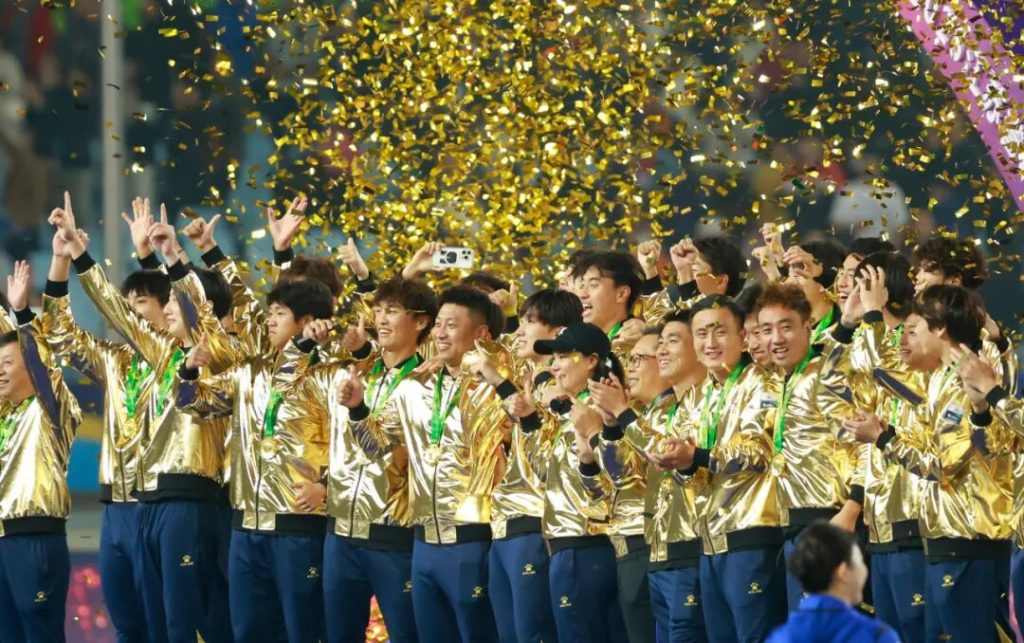
Positive Comments: “Social Breakthrough” in a Low-Sports Year and Reconstructing the Normalized Value of the Sports Ecosystem
The year 2025 is known as a “low-sports year,” yet it demonstrated vitality no less than that of a major sports event year, thanks to the in-depth participation of social platforms. Throughout this year, Weibo, through IP events such as “The Night of Sports Passion” and “Basketball Night,” as well as in-depth operations of athlete IPs and mass sports events, not only broke free from the “major event dependency” but also propelled the sports ecosystem to shift from “event-driven” to “daily operation,” providing a replicable model for the normalized development of the sports industry.
Firstly, social platforms have become the “connectors” of the sports ecosystem, activating the collaboration of diverse entities. In the traditional sports industry, core resources were concentrated on major events, top athletes, and premier competitions. However, during the “low-sports year” of 2025, Weibo connected scattered entities such as individual world championships, mass sports events (e.g., the Jiangsu Super League and Zhejiang BA), cross – border athletes (e.g., Long Daoyi’s foray into trendy music), and e – sports players through the “Sports Glory” system (including 24 honors such as “Annual Notable Event” and “Annual Progressive Athlete”). For instance, the Taizhou team of the Jiangsu Super League became a national cultural event through Weibo’s dissemination, leveraging geographical emotional connections and entertainment – oriented content. After Yang Hansen joined the NBA, he interacted with fans via his Weibo studio account, and both his personal and team accounts gained over a million followers in half a year. These cases illustrate that social platforms are not only channels for information dissemination but also collaborative hubs for diverse entities (athletes, events, brands, and users) in the sports ecosystem, driving sports from the “professional circle” to “national co – creation.”
Secondly, the two – way accumulation of social assets has injected long – term value into the sports industry. In the past, the traffic in the sports industry mainly relied on the “pulsed outbursts” of major events. However, in 2025, Weibo achieved continuous production of sports content and enhanced user stickiness through “daily interaction + long – tail operation.” On one hand, athletes actively participated in social interactions, transforming from “result announcers” to “life sharers.” Active athletes like Yang Hansen shared his daily adaptation to the NBA on Weibo, while retired athletes such as Zhang Guowei and Zhao Lina expanded their influence through high – quality content, personal brands, and public welfare projects. This “authenticity” narrowed the gap between athletes and users, shifting sports narratives from “competition results” to “emotional resonance.” On the other hand, mass sports events (e.g., the Jiangsu Super League) turned months – long event cycles into “social marathons” through continuous pre – heating, topic discussions, and the spread of meme culture on Weibo, which not only satisfied users’ sense of participation but also accumulated long – term attention for the events. Data shows that in 2024, Weibo had 37.04 million in – depth sports users and 120 million general users, with nearly 80% being post – 90s and post – 00s. These highly active and high – spending user groups are the core assets for the future of the sports industry.
Finally, the establishment of a closed – loop from social assets to commercial value has verified the commercial potential of the sports industry during non – major event periods. In the past, the commercial value of sports platforms was often questioned for “relying on the traffic of major events.” However, in 2025, Weibo achieved normalized monetization through the model of “content – driven traffic, and traffic feeding back to business.” For example, events like the F1 Chinese Grand Prix and WTT expanded their online influence by linking with social hotspots and other industries on Weibo. The long – standing popularity of athletes such as Yang Hansen and Sun Yingsha provided continuous exposure for brands. The renewal of the cooperation agreement between the NBA in China and Weibo to build a fan community also addressed concerns regarding event copyrights. This closed – loop benefits multiple parties, including platforms, events, athletes, and brands, and proves that the sports industry can still achieve stable growth in commercial value through refined operations during non – major event periods.
Negative Comments: Potential Hidden Concerns Driven by Social Media, and the “Sustainability” of the Sports Industry Remains to Be Examined
Although the “social breakthrough” in 2025 injected vitality into the low – sports year, some potential problems were also exposed. If not properly addressed, these issues may affect the long – term and healthy development of the sports industry.
Firstly, the “head – concentration effect” of social platforms may squeeze the space for small and medium – sized ecological entities. As the main platform for sports discussions currently, Weibo’s strong user base and content aggregation ability can efficiently integrate resources, but they may also lead to “platform dependency” for sports content. For example, the popularity of mass sports events highly depends on Weibo’s topic operations and traffic support. If the platform adjusts its strategy in the future (e.g., reducing resource allocation), the popularity of these events may quickly decline. The development of athlete IPs also relies on the platform’s recommendation mechanism, and small and medium – sized athletes or emerging sports projects may struggle to grow due to insufficient exposure. Moreover, an overly concentrated platform ecosystem may suppress the differentiated exploration of other social platforms (e.g., Douyin and Xiaohongshu) in the sports field, limiting the diversity of sports content.
Secondly, the “cross – border expansion” of athlete IPs may blur the boundaries of professional value. In 2025, athletes’ cross – border attempts (such as Long Daoyi’s music creation and Zhang Guowei’s social media content) indeed expanded their personal influence, but there is also a risk of “emphasizing traffic over professionalism.” If active athletes invest too much in social interactions and cross – border activities, they may be distracted from training, affecting their competitive performance. If the IP development of retired athletes deviates from the core of “sports spirit” (e.g., being overly entertainment – oriented), it may weaken their value as “sports role models.” For example, some athletes posting low – quality content to pursue traffic may damage the long – term trust of sports IPs. Cross – border collaborations lacking a connection with sports attributes (e.g., simply “riding on the coattails of popularity”) are unlikely to generate sustainable commercial value.
Thirdly, there is a risk of a disconnect between the “social popularity” and “operational capabilities” of mass sports events. The popularity of mass sports events such as the Jiangsu Super League and Zhejiang BA is essentially due to social platforms magnifying their “geographical emotions” and “entertainment attributes.” However, it remains to be seen whether the operational capabilities of these events themselves (such as organizational norms, commercialization models, and youth training systems) can keep up with the growth in popularity. For example, some mass sports events may blindly expand due to a short – term influx of traffic, resulting in insufficient basic support in terms of venues, referees, and funds, ultimately damaging the user experience. If event organizers overly rely on platform traffic and neglect the quality of their own content (such as the excitement of the games and participation thresholds), they may fall into the dilemma of “traffic coming and going” after the popularity fades.
Fourthly, the “sustainability” of the commercial closed – loop faces dual challenges of user growth and content quality. Although Weibo’s sports users are mainly post – 90s and post – 00s, the interests of the younger generation shift quickly. If the platform fails to continuously provide high – quality content (such as in – depth analysis and exclusive interactions), user stickiness may decline. Meanwhile, the pressure of commercial monetization may lead to “over – commercialization” of content, such as an excessive number of brand advertisements and “advertorial – like” athlete content, which actually reduces the user experience. In addition, while the cooperation between Weibo and event IPs (such as the NBA in China) has addressed copyright issues, how to balance “platform interests” and “event organizers’ rights” (such as data sharing and user retention) remains a key factor in long – term cooperation.
Advice for Entrepreneurs: Seize the Social Media Dividend and Deeply Cultivate “Sustainable” Sports Value
The in – depth interaction between the low – sports year of 2025 and social platforms provides important inspiration for entrepreneurs. Based on the experiences and concerns in the news events, the following advice can be considered:
Make Good Use of the “Connector” Attribute of Social Platforms to Create IPs in Niche Areas
Entrepreneurs can focus on niche segments of the sports industry (such as mass sports events, emerging sports, and athlete IP development), leveraging the user base and interaction capabilities of social platforms to transform “small but beautiful” content into a “big impact.” For example, operators of mass sports events need to design differentiated content in combination with regional cultures (such as the “city football” concept of the Jiangsu Super League) and continuously attract attention through topic operations and user co – creation on platforms like Weibo (such as the “National Discussion on the National Games” incentive competition). Entrepreneurs in emerging sports (such as parkour and frisbee) can expand the awareness of their projects through the social interactions of athlete IPs (such as Shang Chunsong, the parkour champion of the World Games) and simultaneously form communities by collaborating with KOLs and enthusiasts.Balance “Traffic” and “Professionalism” to Strengthen the Core Value of Sports IPs
The development of athlete IPs should be centered around the “sports spirit” to avoid excessive entertainment. Active athletes can share their training routines and competition insights on social platforms (such as Yang Hansen’s records of adapting to the NBA), conveying positive values of “perseverance” and “growth.” Retired athletes can develop content based on their professional backgrounds (such as Deng Yaping’s sports education and Liu Xiang’s health science popularization) or establish sports – related brands (such as sports equipment and health food), transforming IP value into commercial value. At the same time, short – sighted behaviors of “putting traffic first” should be avoided to prevent damage to long – term trust due to low – quality content.Build a Dual – Driven Model of “Content + Operation” to Enhance the Sustainability of Mass Sports Events
Entrepreneurs in mass sports events need to strike a balance between “social popularity” and “operational capabilities.” On one hand, they can use social platforms for pre – event warm – up (such as topic discussions), in – event interaction (such as real – time live broadcasts and user comments), and post – event retention (such as highlight reels and user stories), extending the dissemination cycle of the events. On the other hand, they need to improve the basic support of the events (such as venues, referees, and safety) and design reasonable commercialization models (such as local brand sponsorships and membership systems) to avoid the “traffic dependency syndrome.” For example, events like the Jiangsu Super League can learn from the operational experience of professional leagues, establish youth training systems and fan membership systems, and convert short – term popularity into long – term user stickiness.Pay Attention to the Long – Term Accumulation of “Social Assets” and Explore Diverse Commercial Monetization Methods
Entrepreneurs need to recognize that the value of social platforms lies not only in “short – term traffic” but also in the accumulation of “user assets.” For example, they can analyze user preferences through user interaction data (such as comments, likes, and follows) to precisely match brand needs. They can enhance user sense of belonging through community operations (such as fan groups and interest groups), laying the foundation for subsequent paid services (such as membership content and offline activities). At the same time, excessive commercialization should be avoided to maintain the “purity” of the content. For example, when athletes cooperate with brands, they should choose product categories related to sports attributes (such as sports equipment and health products) to ensure that the cooperation content is naturally integrated into the user scenario.
The low – sports year of 2025 was not “small” due to the in – depth participation of social platforms. It not only verified the vitality of the sports industry during non – major event periods but also revealed the reconstructive value of “social assets” for the sports ecosystem. For entrepreneurs, the key to seizing this trend lies in centering on “user needs” and basing on “content quality,” deeply cultivating sustainable sports value in the social media dividend. Only in this way can they gain a foothold in the long – term development of the sports industry.
- Startup Commentary”The Incomplete Evolution History of Bathing Centers”
- Startup Commentary”Starting from 358,800 yuan, Maserati Slashes Prices Drastically to Survive”
- Startup Commentary”Monopoly: Always the Best Business”
- Startup Commentary”A PE Giant Spent $6.6 Billion on a Crematorium”
- Startup Commentary”In a Low-Sports Year, Social Assets Still Hold Great Value”




